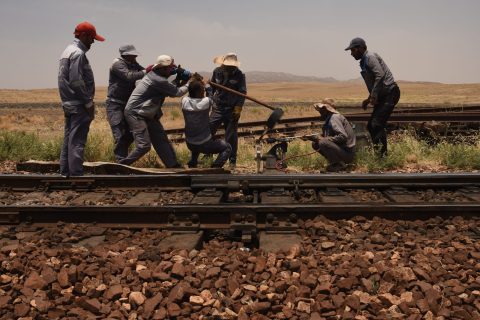European Silk Road Summit live blog: day 1

On 26 and 27 November the European Silk Road Summit took place. This event, held in the Dutch hub of Venlo, is the third edition of the previously named Silk Road Conference. Over two days, around 300 stakeholders on the New Silk Road gathered to discuss the latest developments on this transport route between Europe and China. This is the live blog of day 1.
1718: That’s almost all from us today. We’re off to smoke the room, and get our dinner jackets and evening dresses ready for the gala Summit Dinner. Thanks for being with us, and join us again in the morning.
1715: Wednesday afternoon, we’re all back together for plenary session VII: Connecting the Ports, with presentations from Rotterdam, Baku and the Far East. We’ve two breakouts to finish the day: Transporting Dangerous Goods, and a special Matchmaking Session, which is exactly as it sounds, and gives you thirty minutes to strike a new deal.
1710: We’re opening up at 0900 with a morning session all about transit through Russia. That’s a subject that’s been touched on already today. We’ll be dividing upon for the rest of the morning, to discuss European hubs in one breakout (with a focus on Zeebrugge, Budapest, Luxembourg, and the innovative Railgate Finland). The other choice is a breakout all about choice: Which Modality? We’ll be debating rail, road and sea, all in one session.
1705: So, while we get ready for this evening’s Summit Dinner, what’s on the agenda for tomorrow? Well, those of us fit enough for the Summit 5K (that’s a run, not a new subsidy) there’s plenty to look forward to in the second day sessions.
1700: Winding up now, with some questions about the possibilities of bulk cargos and project cargos by rail to China. The panel welcomes the concept of bulk materials, projects cargos and even oversized cargos – but says there are issues, and it will take some new solutions to make that possible. Is that something you would consider – sending bulks by intermodal to China and the Far East?
1655: One of the day’s most willing delegates, Yingnan Yao from DB Cargo, asks the panel what challenges need to be answered from the European end. Strassburg says there are a lot of regulatory questions to be answered at the European end, and he wished Maja Bakkran Marcich from the EU was still here to help.
1648: Moderator Majorie van Leijen stumps the panel with the burning question of what to do with the imbalance of tangible trade, which means there’s a net flow of empty containers to China. That’s not good for logistics and not good for trade. It is, admittedly a tough question to answer. Maybe global is the answer, with boxes orbiting the world, instead of coming back, directly to Europe. The panel agrees it will take a while and we need to work smarter to make it better balanced.
1645: Kowitzki fields questions about whether there’s a commercial push towards using rail over other modes. He says that DHL for one is not pushing customers towards rail on the Silk Road, but that’s a choice that customers are having to make. They’re thinking more about the things that make rail transport more attractive and make a difference to their bottom line – such as perceived lower carbon footprint.
1643: Strassburg says he’s concerned about the level of restriction on designated dangerous goods – such as batteries. He thinks that there’s a logic problem with banning things like batteries from freight trains, but allowing explosives to be transported by road. Are dangerous goods restrictions something you’ve encountered in your proposed trade with China?
1642: What do you think? Has the removal of subsidies, forcing containers to be full before departure, made a positive difference?
1640: The Chinese government removal of subsidies (for empty containers westbound) is welcomed as a good decision by the panel.
1638: Hawranek: “It’s faster transit and new routes – like via Kaliningrad.
1636: Kowitzki: “Never seen so many requests like this year for China rail. Customers seem to have realised that it’s possible to get goods to China by rail. Lead times are much faster too.
1634: Hasenkampf – “We’ve seen a drop in the number of empty containers going east.” This time last year, he says, we were sending hundreds of empty containers east.
1632: Strassburg: “The big change has been the ban on westbound empty containers (from China). If a train of 41 containers has one empty, it doesn’t leave”, is the issue DB Schenker is addressing.
1625: We’re moving on to the last session of the day, and it’s a big one. Headlined as Consolidation in 2019: the effect of new policies. We’ll get to that in a few minutes, but let’s introduce the heavyweight panel. There’s Dmitri Hasenkampf, the Eurasia representative for DB Cargo, Roland Hawranek from block train operator BTE, Thomas Kowitzki from DHL Forwarding, and Jan Rainer Strassburg from DB Schenker.
1617: So, is this the right mode for LCL? That’s something we’ll return to tomorrow. That should be a heated one – there are shippers from all disciplines in the theatre.
1612: LCL questions from the floor: There’s the paperwork. Does a single waybill in an LCL consignment stop a whole container? Well, in short yes, and the solution is just to eliminate that issue at source. If it not right, it’s not on the train, that’s the logical solution. Might that be a bigger problem in a future that’s seeing a step-change in LCL trains? Time will tell.
1607: Capacity questions from the floor: Something that will exercise the minds of UK readers: a question about single track routes which constrain capacity? Something that brings surprisingly little concern from the panel. Perhaps its a hangup we needn’t be so concerned about ourselves?
1603: “International postal trade laws are changing.” That means the cost of shipping will increase for inline with the charges of the receiving country. That could make a big difference to the costs of exports, especially for China, says Mossing-Holsteijn. That could make rail freight much more attractive. Is the New Silk Road about to become mainstream?
1600: “Xie Jinping has visited Duisburg, and wherever the government goes, everyone in China wants to follow.” Nunner’s Mossing-Holsteijn observes something of Chinese business culture (so he should, he’s working China often). Is he sending a message to other hubs about who they should invite to their opening ceremonies?
1555: “Nunner is already doing LCL on a regular basis between Europe and China.” That’s a modern logistics challenge, but it proves that it’s possible.
1550: “We need to get from anywhere in Europe to anywhere in China without any real challenges along the way.” Mossing-Holsteijn says Nunner is well along the Silk Road already, and is making this happen. His point being that it may have been difficult, but it’s always most difficult to be a pioneer.
1545: “Does the European rail network have the capacity to handle that new demand?” Labinsky poses the question just as he hands the stage over to someone who deals in that area of logistics: Wubbo Mossing-Holsteijn, whose company, Nunner, is pretty much a LCL writ large across Europe.
1540: Taking in both directions, just the demand between East Asia and Europe will be 8.2m TEU by next year, but 11.4m TEU by 2035. However, Labinsky says that there’s an overall spare capacity of 28% already, and, given the capacity development planned, that could grow to 78% by 2035. That’s the nearest this audience has come to a gasp of surprise. That though doesn’t take into account the big intangible: modal shift.
1535: “There is a possible tripling of transshipment capacity, but is there the demand to satisfy it?”
1533: We’re back for the afternoon session. Starting with a really vital debate: will forecast demand and actual capacity align any time in the near future? Complicated, but we’re lucky to have Alexander Labinsky, project manager, mobility and transport at Prognos AG, the Swiss headquartered independent industrial research consultancy.
1505: We’ll be back after a breath of fresh air on the banks of the Maas. See you again at 1530.
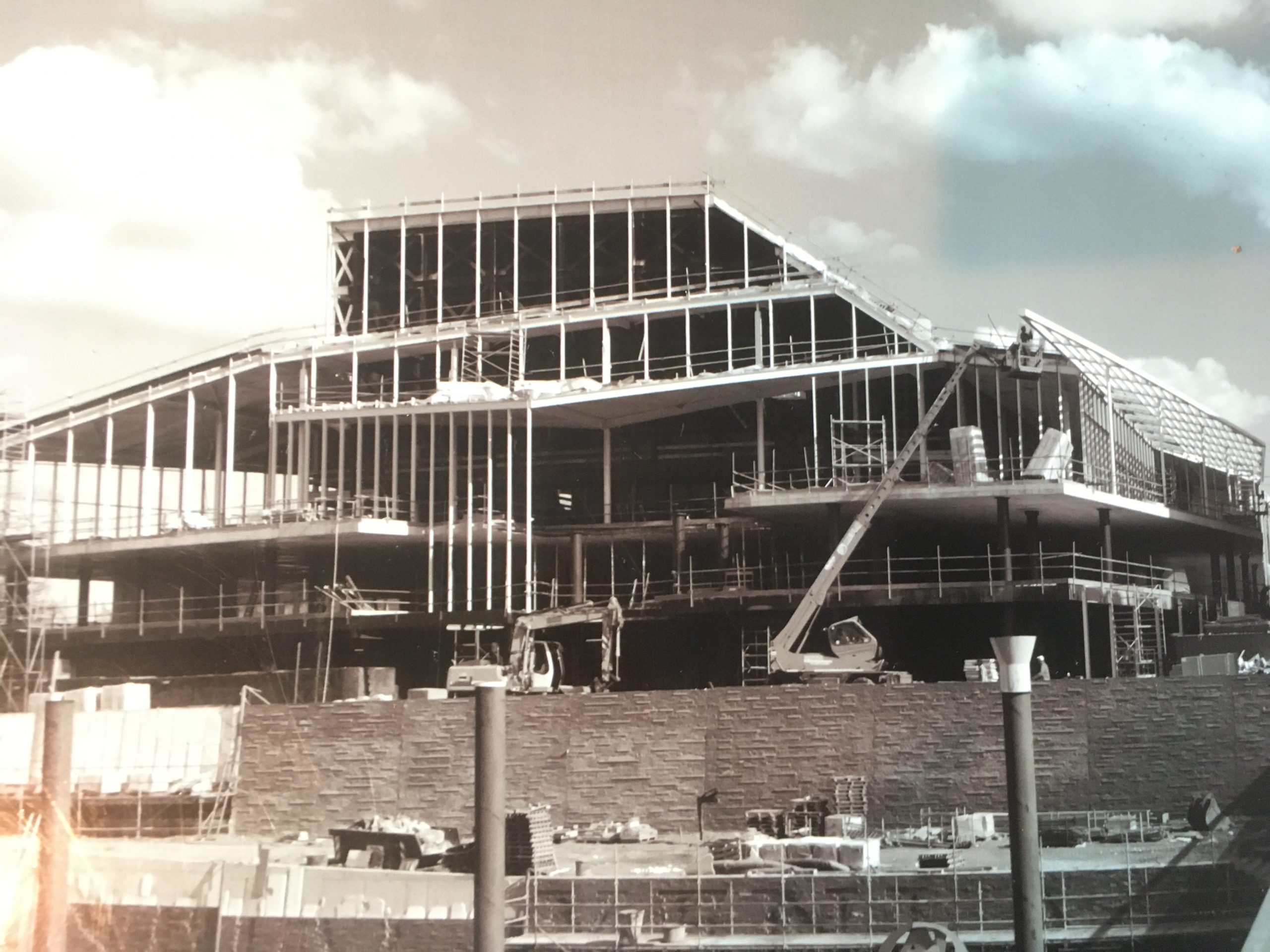
1500: Final question before coffee: Is putting a 45-foot container on a 60-foot wagon better than putting it on a road trailer? That’s a discussion that’s going on over the cappuccino machine in the foyer.
1455: We’ve moved on to a couple of thorny issues; over length containers (45 foot reefers) and subsidies. Your correspondent’s British ears are amused to hear this continental audience getting worked up over imperial measurements. Joking apart, fitting in longer trains is a big issue when crossing borders. Are you reading this in Poland? Your ears must be burning. Is that an issue you’re familiar with and what’s to be done to resolve it?
1450: A DB Cargo delegate says they are moving cars to China on double-deck trains. “80 per cent more capacity than a usual container train.” That’s 200 instead of 123 vehicles for the same length of train. Maybe intermodal isn’t always the answer. Now, how do we get those car carriers back?
1445: “There’s competition for sure, but there’s a growing market.” If there is anything that makes business think harder about breaking down barriers, then it’s the prospect of more business. With the market growing, now is the time to take in hand the political, regulatory, and logistics challenges of Silk Road trade. If that means adapting to longer trains, now is the time to get to work on longer sidings”, said Tijs.
1440: Making the Road2Holland work. Chris Wensink (of Panteia) and Marcel Tijs (Dutch Ministry of Water and Infrastructure) are on stage to discuss the challenges of making connections work. Quite a challenging session this, asking the difficult questions and taking the line that Silk Road isn’t as smooth as, well, silk. Making it work takes effort and willingness.
1430: “If you want to do business with China, it’s like a great big water basin. You don’t need to go looking for the water, just the plug.” Logistics expert Bertram makes an unusual metaphor. Is that how you see it?
1429: Markus makes light of customs and regulations, but we think is not happy about governments with state-controlled facilities that make it difficult to do business. He says there are enough logistic problems without extra political ones. Murmurings of agreement from the audience.
1426: Markus Bertram of rail carrier LTE takes the stage – since it’s his trains that have to be filled.
1425: “We have the Holland House in Chengdu, complete with a windmill.” Verbraak says GVT has a great innovative way to promote products in China and help fill those eastbound trains.
1420: It’s not all straight forward, says Verbraak. Sending goods to China has a whole raft of legislation and regulation to handle.
1418: Roland Verbraak (GVT Intermodal) makes the case for Tilburg. Moving on Tilburg’s connection with Chengdu. Five train a week between the twinned cities.
1415: Moving on – Pitching for a Better Connection. Is this a Dragon’s Den for the Silk Road? Well, there are four hopefuls on the stage…
1411: “Gauge change is an issue in Russia,” says Pardoel, answering the audience. That may not be the first challenge that comes to mind when transiting Russia, but Peter says political situations change. That’s interesting insight – since it’s probably easier to change the width of government, than it is to change the width of a rail network. Thanks Peter!
1410: “No capacity issues and no congestion issues around Venlo.” In the face of questions from the hall, Peter Pardoel is robust in his reasons for promoting his home town as an even greater international logistics hub.
1407: We’ll be hearing more about Baku, and how the port plays an increasing role in Silk Road trade, later in the Summit.
1405: “1.2m TEU, that’s our aim for cargo handling through Venlo,” says Pardoel in conclusion.
1400: Next steps, says Pardoel: connecting India, Pakistan and Central Asia. Clearly Cabooter has ambition – and also vision. The audience is checking out their post facility in Baku as part of the presentation.
1355: China – Baku – Instanbul – Budapest – Venlo. That’s the route Cabooter is looking at as an alternative to traditional shipping routes. Peter Pardoel makes his presentation clear on the grounds of economy of logistics.
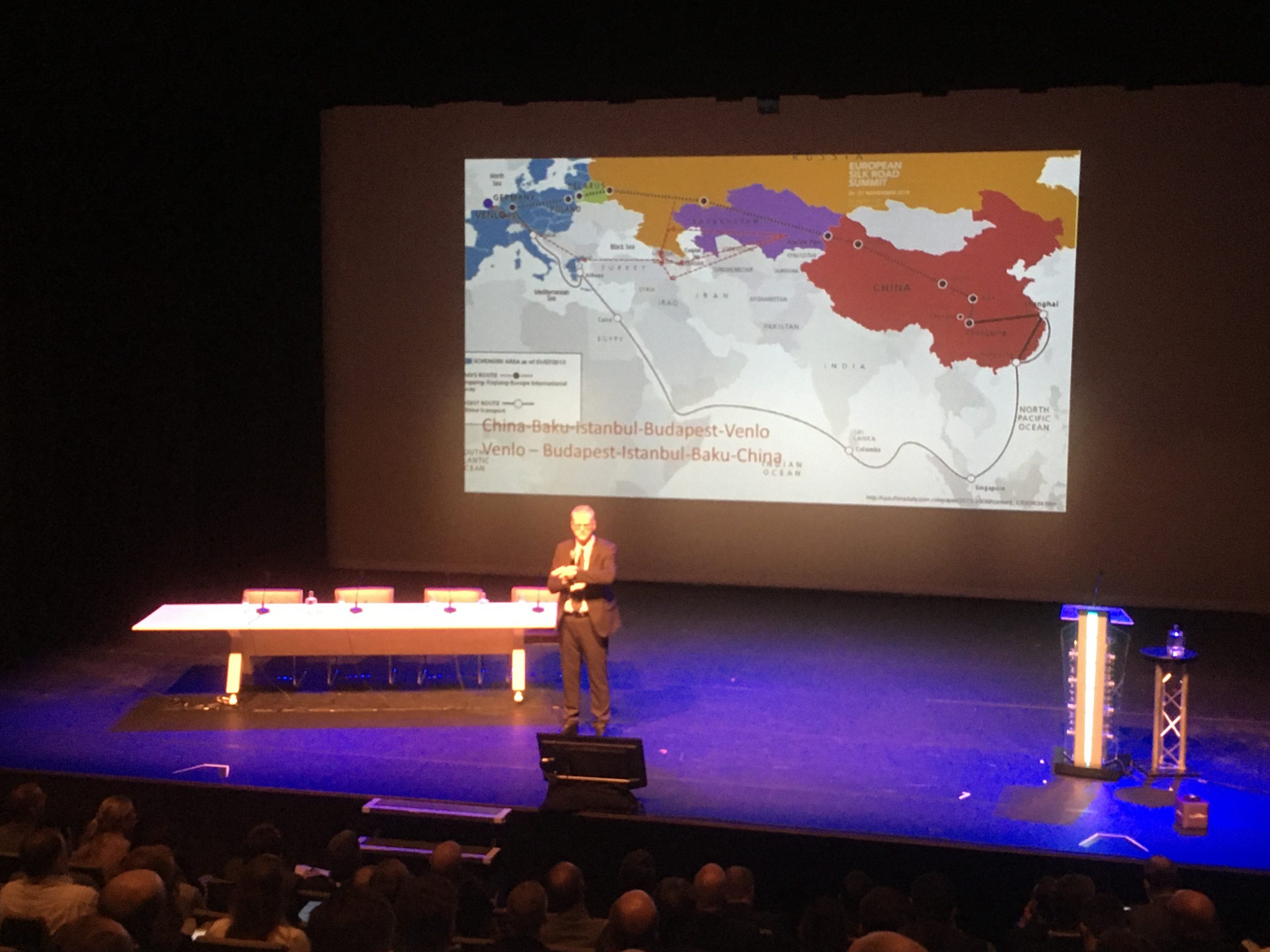
1355: Over the years, Pardoel has been out on fact-finding missions to China, on behalf of his company Cabooter Group. “The China of then and now is so different, it’s unbelievable. At one time, China and India could be compared economically, now there is a vast difference.”
1350: Pardoel says 1800 trains were operated from China to Europe last year, on target for 2500 this year.
1345: Cabooter Group’s Peter Pardoel is giving a presentation on the sixty-year old family run logistics company from right here in Venlo. The company is moving with the times.
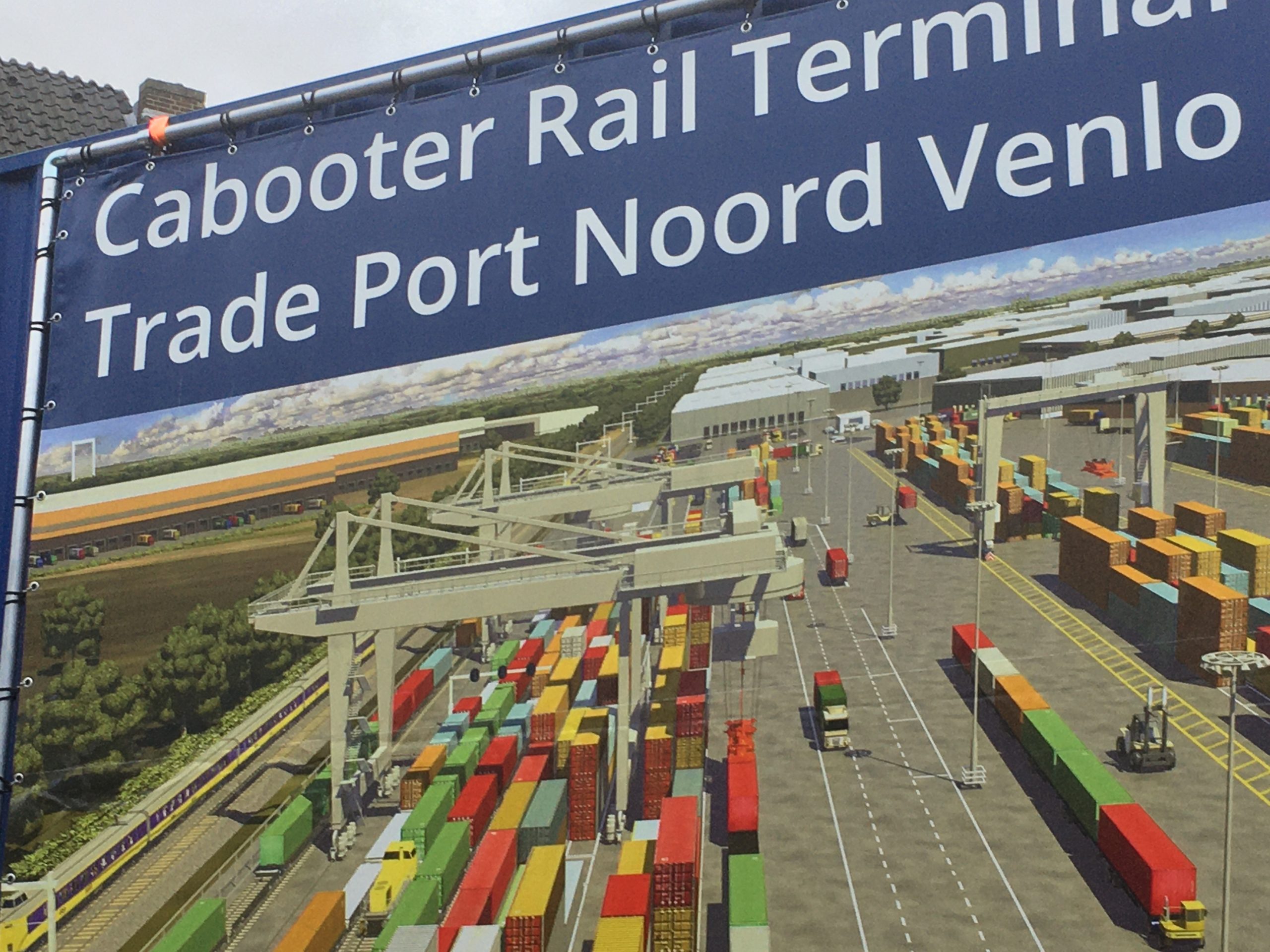
1344: The mayor concludes with another keen observation: “When national borders are disappearing, co-operation becomes the key.”
1343: “Multimodal transport is the answer to an ever-changing world.” The mayor sees the value of embracing standardisation to allow diversity.
1341: The mayor lays out the recent logistics and infrastructure installations, both delivered and planned. “Many logistics companies have chosen to settle here in our city. Venlo is the best option for rapid transit to the rest of Europe, by water, road and rail. Sea shipping is no longer the only option for intercontinental freight traffic.”
1340: Well, who can blame us for being a little late back. The lunch here at Maaspoort convention centre is very good indeed. We’re back in session now, and all stand for the Mayor of Venlo, Antoin Scholten.
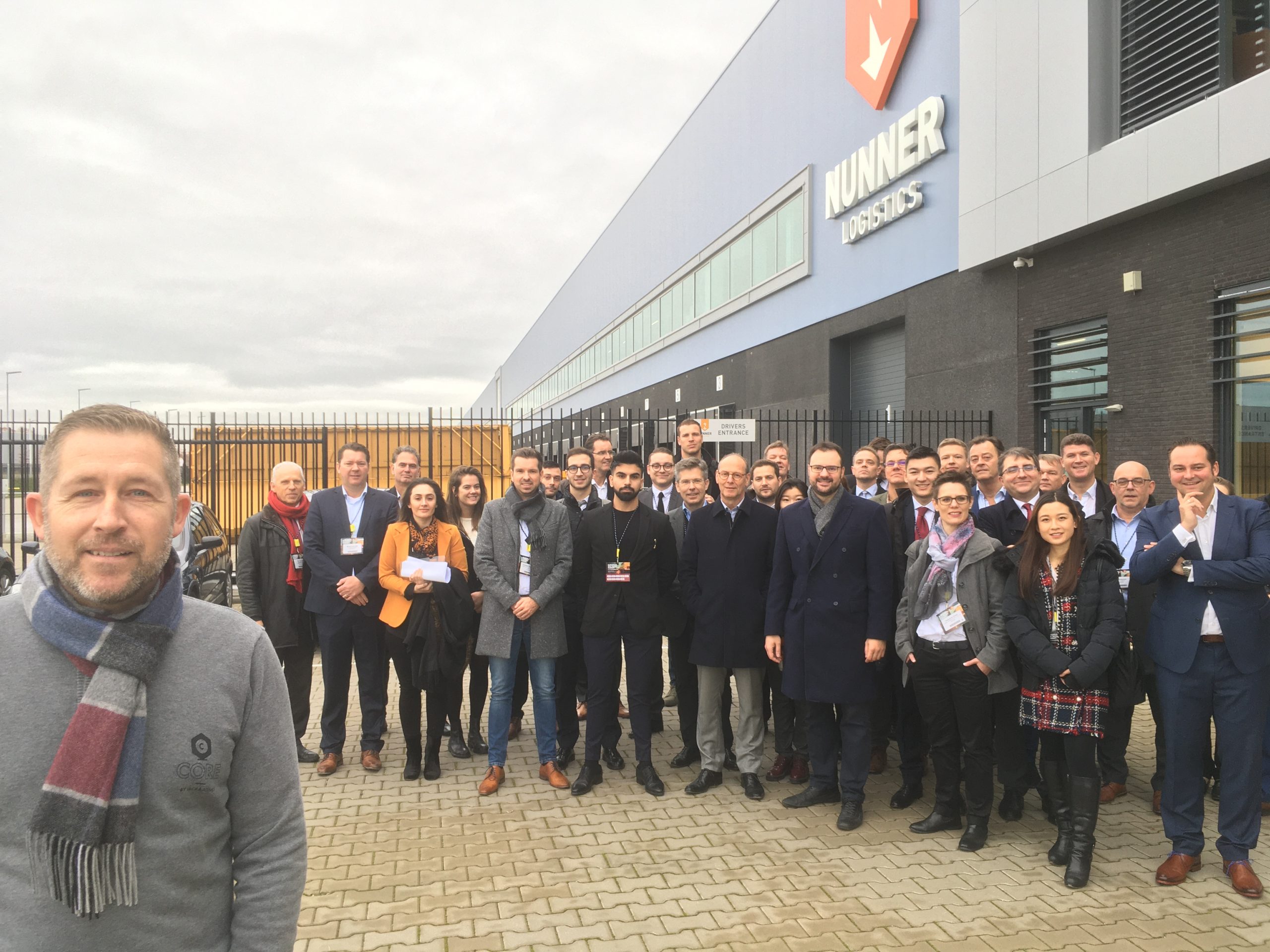
1245: OK. We’re taking lunch now, back in business at 1330 CET…
1235: The vice-governor says we can use the Silk Road for far more than just trade, and, echoing the Minister Councillor, he says there is much of cultural value too. I think we all know that he still has an astute eye on trade though.
1232: One governmental representative to another. A response and thanks from Joost van den Akker, who’s the vice-governor of the Deputy States, Province of Limburg. Don’t let he official title mislead you. Joost van den Akker is an engaging and confident speaker, who has the audience just as attentive as our Chinese guest of honour.
1231: “Even the mountains and the seas cannot separate people with common goals,” as the Minister concludes with a Chinese Proverb.
1230: “China will act to better protect intellectual property,” says Minister Chen Ribao, aware of the issues of concern in the West.
1227: “I hope Venlo and Limburg will have a greater importance in the development of Silk Road trade between The Netherlands and China,” says Ribao, as he gives the first day Keynote Speech to nearly 300 delegates here at the New Silk Road Summit in the Maasport convention centre in Venlo.
1226: “The Netherlands is the gateway to Europe. China and The Netherlands are at opposite ends of the Silk Road.” He says that although a Memorandum of Understanding is not yet signed, there’s already health trade between NL and China, and the Silk Road is playing a huge part in making that a reality. “Mutual trust, connectivity, and trade,” he says, has made the Netherlands the second biggest Silk Road partner in the EU.
Netherlands the second biggest Silk Road partner in the EU
1225: The Minster, who’s travelled from the embassy in The Hague to be here this morning, says he’s a frequent visitor to Limburg Province.
1220: “I’m sorry,” says Ribao. “My train was late!” So the minister has the audience laughing the aisles from the very start. He gives what was supposed to be he first day keynote speech to nearly 300 delegates here at the New Silk Road Summit in the Maasport convention centre in Venlo.
1215: We’re anticipating the arrival of Chen Ribao, Minister Counsellor of the Chinese Embassy here in The Netherlands.
1200: Maja Bakran Marcich, Deputy Director General at the European Commission’s DG MOVE, the EU – China Cooperation initiative, joined us once again at the Summit. She’s giving the full house a brand new presentation, bringing together, as she explained, the four pillars of Silk Road communication: energy, digital connectivity, human interactions, and of course transport.
There are many synergies between BRI and TEN-T, says Marcich. She explained the importance of establishing the Trans-European Transport Network (the TEN-T). With the even wider horizons of Silk Road trade, the huge task of integrating rail systems across Europe, are even more complicated when bringing together the many systems that run though the corridors of the Silk Road.
The EU-China Connectivity Platform is probably the biggest logistics challenge to making Silk Road trade work efficiently. This is clearly her focus, and she’s taking probing questions from the floor with ease.
1100: we are underway! Let’s start by getting to know everyone. We’re going round the theatre, introducing delegates from Asia, Africa, Europe and even from right here in Venlo.
0800: Just hours away from the opening address. Before that though, we’re out to see Silk Road trade in action at two site visits here in Venlo, taking in locations on the Greenport Venlo initiative. We will see with our own eyes how this Dutch location is becoming a hub for international trade.
You just read one of our premium articles free of charge
Want full access? Take advantage of our exclusive offer




